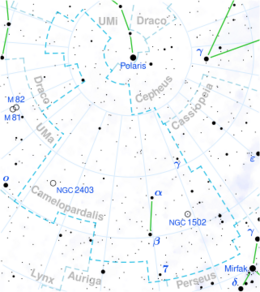Astronomy:HD 46509
| Observation data Epoch J2000.0 Equinox (celestial coordinates) | |
|---|---|
| Constellation | Camelopardalis |
| Right ascension | 06h 40m 32.25255s[1] |
| Declination | +71° 44′ 55.6296″[1] |
| Apparent magnitude (V) | 5.86±0.01[2] |
| Characteristics | |
| Spectral type | G9 III[3] or K0 III[4] |
| B−V color index | +1.19[5] |
| Astrometry | |
| Radial velocity (Rv) | −24.02±0.19[6] km/s |
| Proper motion (μ) | RA: +4.653[1] mas/yr Dec.: +11.103[1] mas/yr |
| Parallax (π) | 4.1248 ± 0.0376[1] mas |
| Distance | 791 ± 7 ly (242 ± 2 pc) |
| Absolute magnitude (MV) | −0.98[7] |
| Details | |
| Mass | 5.64±1.82[8] M☉ |
| Radius | 27.3±0.6[1] R☉ |
| Luminosity | 399±7[1] L☉ |
| Surface gravity (log g) | 2.34±0.11[8] cgs |
| Temperature | 4,675±92[8] K |
| Metallicity [Fe/H] | +0.12±0.05[8] dex |
| Rotational velocity (v sin i) | 1.5±1.2[9] km/s |
| Age | 339+78−63[8] Myr |
| Other designations | |
| Database references | |
| SIMBAD | data |
HD 46509, also designated as HR 2396, is a solitary star located in the northern circumpolar constellation Camelopardalis, the giraffe. It is faintly visible to the naked eye as a yellowish-orange hued point of light with an apparent magnitude of 5.86.[2] The object is located relatively far at a distance of 791 light-years based on Gaia DR3 parallax measurements,[1] but it is drifting closer with a heliocentric radial velocity of −24.02 km/s.[6] At its current distance, HD 46509's brightness is diminished by interstellar extinction of 0.31 magnitudes and it has an absolute magnitude of −0.98.[7]
HD 46509 has a stellar classification of either G9 III or K0 III,[3][4] with both classes indicating that it is an evolved red giant. It is estimated to be 339 million years old,[8] enough time for it to cool and expand to 27.3 times the radius of the Sun.[1] HD 46509 has about 5.6 times the mass of the Sun[8] and it radiates 399 times the luminosity of the Sun[1] from its enlarged photosphere at an effective temperature of 4,675 K.[8] It is metal enriched with an iron abundance 132% that of the Sun's ([Fe/H] = +0.12)[8] and like most giant stars, it spins slowly with a projected rotational velocity of approximately 1.5 km/s.[9]
References
- ↑ 1.0 1.1 1.2 1.3 1.4 1.5 1.6 1.7 1.8 Vallenari, A. et al. (2022). "Gaia Data Release 3. Summary of the content and survey properties". Astronomy & Astrophysics. doi:10.1051/0004-6361/202243940 Gaia DR3 record for this source at VizieR.
- ↑ 2.0 2.1 Høg, E.; Fabricius, C.; Makarov, V. V.; Urban, S.; Corbin, T.; Wycoff, G.; Bastian, U.; Schwekendiek, P. et al. (March 2000). "The Tycho-2 catalogue of the 2.5 million brightest stars". Astronomy and Astrophysics 355: L27–L30. ISSN 0004-6361. Bibcode: 2000A&A...355L..27H.
- ↑ 3.0 3.1 Wilson, Ralph E.; Joy, Alfred H. (March 1950). "Radial Velocities of 2111 Stars.". The Astrophysical Journal 111: 221. doi:10.1086/145261. ISSN 0004-637X. Bibcode: 1950ApJ...111..221W.
- ↑ 4.0 4.1 Halliday, Ian (September 1955). "Luminosity Function and Space Motions of G8-K1 Stars Derived from Spectroscopic Parallaxes.". The Astrophysical Journal 122: 222. doi:10.1086/146080. ISSN 0004-637X. Bibcode: 1955ApJ...122..222H.
- ↑ Haggkvist, L.; Oja, T. (1970). "Results of BV photometry 1969-70 (Uppsala refractor)". Private Communication. Bibcode: 1970Priv.........0H.
- ↑ 6.0 6.1 Famaey, B.; Jorissen, A.; Luri, X.; Mayor, M.; Udry, S.; Dejonghe, H.; Turon, C. (January 2005). "Local kinematics of K and M giants from CORAVEL/Hipparcos/Tycho-2 data. Revisiting the concept of superclusters". Astronomy and Astrophysics 430: 165. doi:10.1051/0004-6361:20041272. Bibcode: 2005A&A...430..165F.
- ↑ 7.0 7.1 Anderson, E.; Francis, Ch. (May 2012). "XHIP: An extended hipparcos compilation". Astronomy Letters 38 (5): 331–346. doi:10.1134/S1063773712050015. ISSN 1063-7737. Bibcode: 2012AstL...38..331A.
- ↑ 8.0 8.1 8.2 8.3 8.4 8.5 8.6 8.7 8.8 Feuillet, Diane K.; Bovy, Jo; Holtzman, Jon; Girardi, Léo; MacDonald, Nick; Majewski, Steven R.; Nidever, David L. (20 January 2016). "Determining Ages of APOGEE Giants with Known Distances". The Astrophysical Journal 817 (1): 40. doi:10.3847/0004-637X/817/1/40. Bibcode: 2016ApJ...817...40F.
- ↑ 9.0 9.1 de Medeiros, J. R.; Mayor, M. (November 1999). "A catalog of rotational and radial velocities for evolved stars". Astronomy and Astrophysics Supplement Series 139 (3): 433–460. doi:10.1051/aas:1999401. ISSN 0365-0138. Bibcode: 1999A&AS..139..433D.
- ↑ "HD 46509". SIMBAD. Centre de données astronomiques de Strasbourg. http://simbad.u-strasbg.fr/simbad/sim-basic?Ident=HD+46509.
 |

